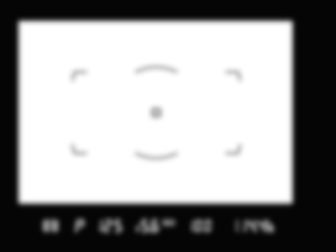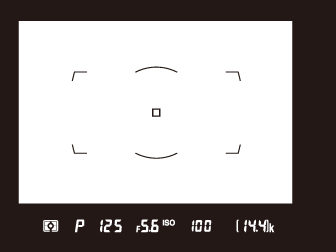Parts of the Camera
- Camera Body
- The Power Switch
- The Top Control Panel
- The Rear Control Panel
- The Viewfinder
- The Live View Displays (Photos/Movies)
- Touch Controls
Camera Body
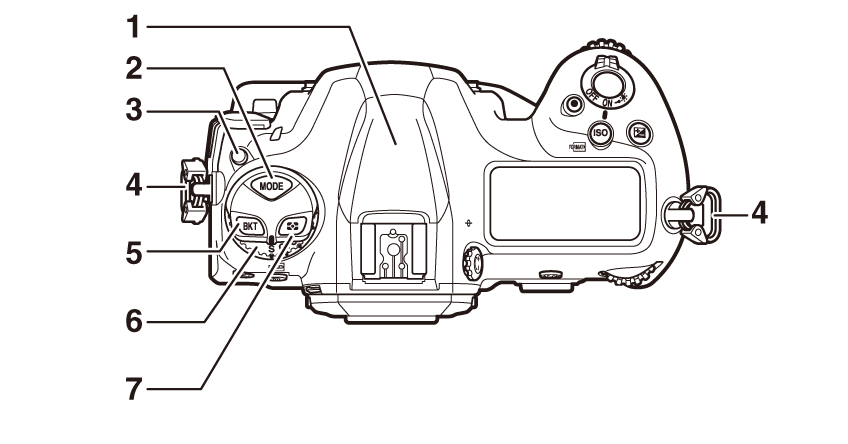
| 1 |
GNSS antenna (Location Data) |
|---|---|
| 2 |
I button ( The I Button ) |
| 3 |
Release mode dial lock release (Choosing a Release Mode, Choosing the Operation Performed When the Shutter Is Released (Release Mode) ) |
| 4 |
Eyelet for camera strap (Attaching the Strap) |
| 5 |
BKT button ( The BKT Button , Exposure and Flash Bracketing , White Balance Bracketing , ADL Bracketing ) |
|---|---|
| 6 |
Release mode dial ( The Release Mode Dial and S Button , Choosing the Operation Performed When the Shutter Is Released (Release Mode) ) |
| 7 |
Y button ( The Y Button , Exposure-Related Settings (Metering and Exposure Compensation) ) |
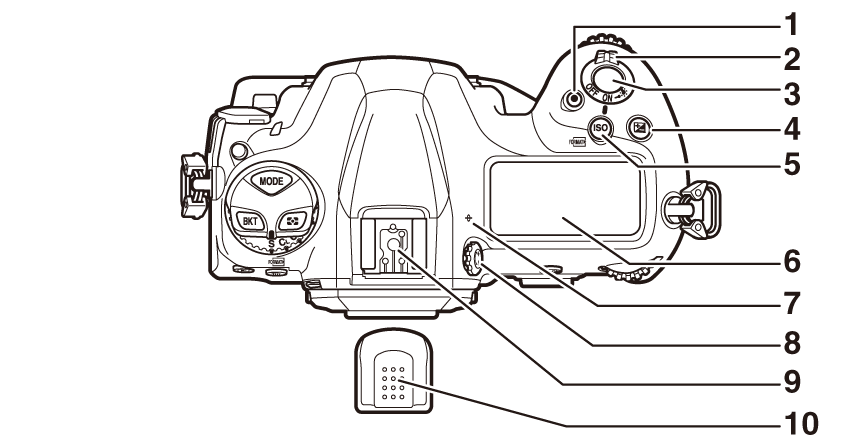
| 1 |
Movie-record button ( Recording Movies ) |
|---|---|
| 2 |
Power switch (The Power Switch) |
| 3 |
Shutter-release button (Taking Photographs) |
| 4 |
E button ( The E Button , Exposure Compensation ) |
| 5 |
S (Q) button ( The S (Q) Button , Adjusting the Camera’s Sensitivity to Light (ISO Sensitivity), Format Memory Card ) |
| 6 |
Top control panel (The Top Control Panel, The Top Control Panel) |
|---|---|
| 7 |
E (focal plane mark; The Focal Plane Mark and Flange-Back Distance ) |
| 8 |
Diopter adjustment control ( The Diopter Adjustment Control ) |
| 9 |
Accessory shoe (for optional flash unit; Using an On-Camera Flash ) |
| 10 |
Accessory shoe cover (The BS-3 Accessory Shoe Cover) |
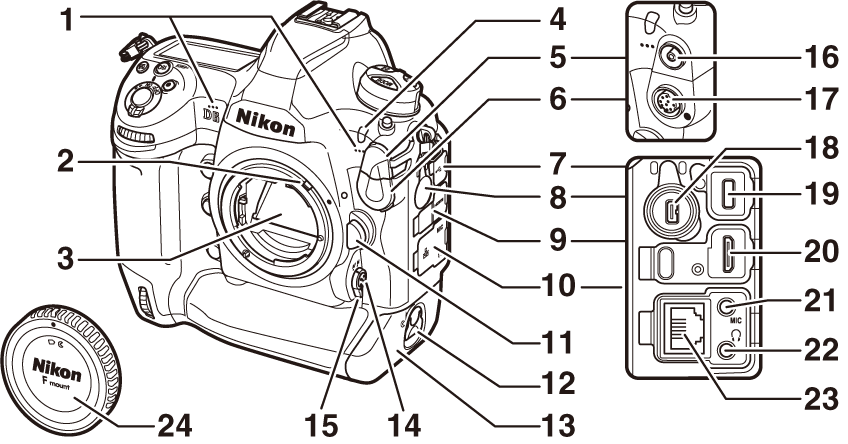
| 1 |
Stereo microphone (for movies; Recording Movies ) |
|---|---|
| 2 |
Meter coupling lever |
| 3 |
Mirror ( Recording Movies , Manual Cleaning ) |
| 4 |
Self-timer lamp ( Using the Self-Timer (E) ) |
| 5 |
Flash sync terminal cover |
| 6 |
Ten-pin remote terminal cover |
| 7 |
USB connector cover |
| 8 |
Peripheral connector cover |
| 9 |
HDMI connector cover |
| 10 |
Cover for microphone, headphone, and Ethernet connectors |
| 11 |
Lens release button ( Detaching Lenses ) |
| 12 |
Battery-chamber cover latch ( Inserting the Battery ) |
| 13 |
Battery-chamber cover ( Inserting the Battery ) |
|---|---|
| 14 |
AF-mode button ( The AF‑Mode Button , Choosing an Autofocus Mode, Choosing an AF-Area Mode) |
| 15 |
Focus-mode selector ( The Focus-Mode Selector , Choosing a Focus Mode , Manual Focus ) |
| 16 |
Flash sync terminal (The Sync Terminal) |
| 17 |
Ten-pin remote terminal |
| 18 |
Peripheral connector ( Attaching the WT-6 ) |
| 19 |
USB connector (Connecting via USB) |
| 20 |
HDMI connector ( Connecting to HDMI Devices ) |
| 21 |
Connector for external microphone (Using an External Microphone) |
| 22 |
Headphone connector ( Headphone Volume ) |
| 23 |
Ethernet connector ( Connecting an Ethernet Cable ) |
| 24 |
Body cap ( Attaching a Lens ) |
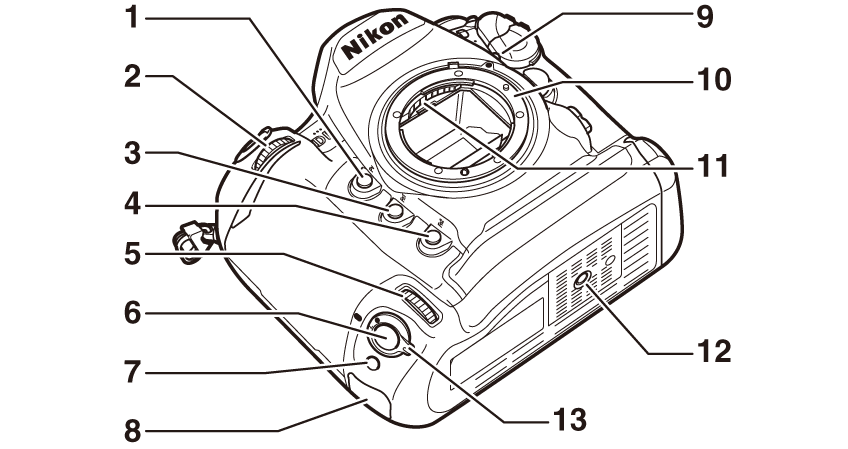
| 1 |
Pv button (Previewing Focus During Live View, The Pv Button , Depth-of-Field Preview ) |
|---|---|
| 2 |
Sub-command dial ( f6: Customize Command Dials ) |
| 3 |
Fn1 button ( The Fn1, Fn2, Fn3 (C), and Fn (Vertical) Buttons ) |
| 4 |
Fn2 button ( The Fn1, Fn2, Fn3 (C), and Fn (Vertical) Buttons ) |
| 5 |
Sub-command dial for vertical shooting ( f6: Customize Command Dials ) |
| 6 |
Shutter-release button for vertical shooting |
| 7 |
Fn button (vertical; The Fn1, Fn2, Fn3 (C), and Fn (Vertical) Buttons ) |
| 8 |
Security slot (for anti-theft cable; The Security Slot ) |
|---|---|
| 9 |
Lens mounting mark ( Attaching a Lens ) |
| 10 |
Lens mount ( Attaching a Lens ) |
| 11 |
CPU contacts |
| 12 |
Tripod socket |
| 13 |
Vertical shooting shutter-release button lock (Framing Photos in Portrait (“Tall”) Orientation) |
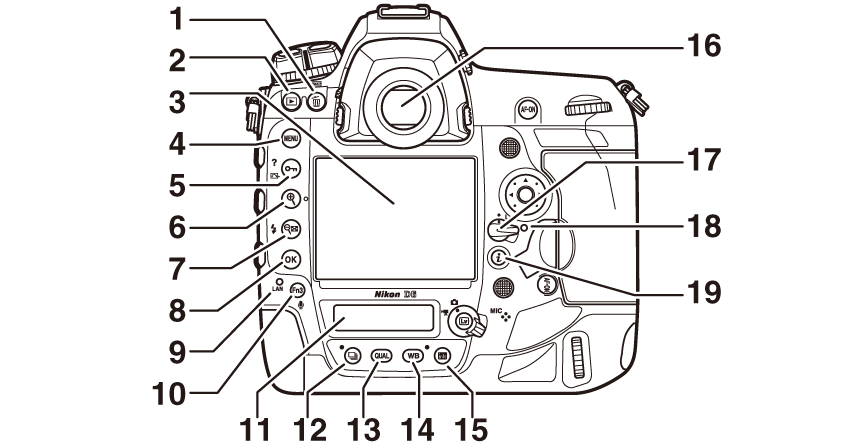
| 1 |
O (Q) button ( Deleting Unwanted Pictures , Using the Delete Button, Format Memory Card ) |
|---|---|
| 2 |
K button ( Playback , Viewing Pictures) |
| 3 |
Monitor ( Touch Controls , Framing Photographs in the Monitor (Live View) , Recording Movies , Playback Touch Controls ) |
| 4 |
G button ( The G Button , Menu Guide) |
| 5 |
g (h/Q) button ( The d (Help) Icon , The g (h/Q) Button , Choosing a Picture Control, Protecting Pictures from Deletion ) |
| 6 |
X button (Live View Zoom Preview, Playback Zoom ) |
| 7 |
W (M) button (Live View Zoom Preview, The W (N) Button , Choosing a Flash Mode , Adjusting Flash Compensation) |
| 8 |
J (OK) button (Using the Menus) |
| 9 |
Network indicator (Connection Status) |
| 10 |
Fn3 (C) button ( The Fn1, Fn2, Fn3 (C), and Fn (Vertical) Buttons , Voice Memos ) |
| 11 |
Rear control panel (The Rear Control Panel, The Rear Control Panel) |
|---|---|
| 12 |
S button ( The Release Mode Dial and S Button , Quick Release-Mode Selection , Two-Button Reset: Restoring Default Settings ) |
| 13 |
T button ( The T Button , Choosing an Image Quality Option, Choosing an Image Size) |
| 14 |
U button ( The U Button , Achieving Natural Colors with Different Light Sources (White Balance), Two-Button Reset: Restoring Default Settings ) |
| 15 |
R button ( The R Button ) |
| 16 |
Viewfinder ( The Diopter Adjustment Control ) |
| 17 |
Focus selector lock ( Focus Point Selection ) |
| 18 |
Memory card access lamp ( Inserting Memory Cards ) |
| 19 |
i button ( The i Button (the i Menu) , The i Button ) |
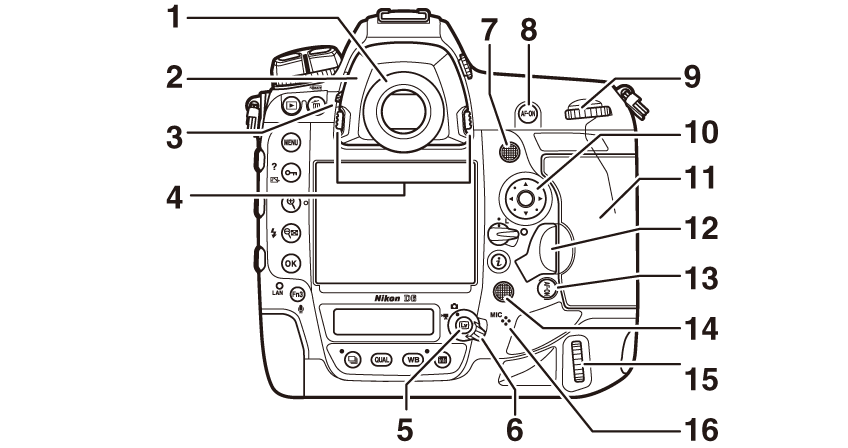
| 1 |
Viewfinder eyepiece (Attaching Diopter-Adjustment Viewfinder Lenses) |
|---|---|
| 2 |
Eyepiece adapter (Removing the Eyepiece Adapter) |
| 3 |
Eyepiece shutter lever ( The Viewfinder Eyepiece Shutter ) |
| 4 |
Eyepiece adapter latch (Removing the Eyepiece Adapter) |
| 5 |
a button ( Framing Photographs in the Monitor (Live View) , Recording Movies , f10: Live View Button Options ) |
| 6 |
Live view selector ( Framing Photographs in the Monitor (Live View) , Recording Movies ) |
| 7 |
Sub-selector ( The Sub-Selector , Focus Lock , Autoexposure Lock ) |
| 8 |
AF‑ON button ( The AF‑ON Button , Locking Focus with the AF-ON Button ) |
| 9 |
Main command dial ( f6: Customize Command Dials ) |
|---|---|
| 10 |
Multi selector (Using the Menus, The J Button and Multi Selector ) |
| 11 |
Memory card slot cover ( Inserting Memory Cards ) |
| 12 |
Card slot cover release button cover ( Inserting Memory Cards ) Card slot cover release button (under cover; Inserting Memory Cards ) |
| 13 |
C button (The AF-ON Button for Vertical Shooting ) |
| 14 |
Multi selector (vertical; Portrait Orientation) |
| 15 |
Main command dial (vertical; f6: Customize Command Dials ) Speaker |
| 16 |
Microphone (for voice memos; Recording Voice Memos) |
If possible, stay in the open when using location data services. Keep the antenna pointed to the sky for best reception.
Be sure to close the covers when the connectors are not in use. Foreign matter in the connectors could cause malfunction.
Close proximity to the speaker could corrupt data stored on magnetic stripe cards or other such magnetic storage devices. Keep magnetic storage devices away from the speaker.
The security slot serves as an attachment point for third-party anti-theft cables.
It is compatible and intended for use with Kensington security cable locks. For more
information, see the documentation provided with the security cable lock.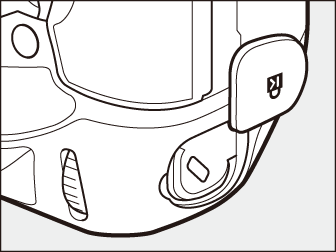
The Power Switch
Rotate the power switch to the “ON” position as shown to turn the camera on. Returning
the switch to the “OFF” position turns the camera off.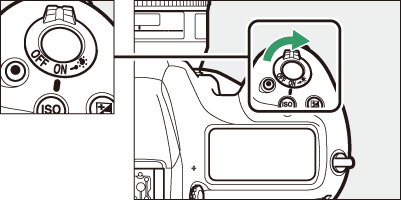
Rotating the power switch to D activates the backlights for the buttons and control panels (LCD illuminator). The
backlights will remain lit for a few seconds after the power switch is released. The
backlights turn off when the switch is rotated to D a second time or the shutter is released. Activating the button backlight makes the
camera easier to use in the dark.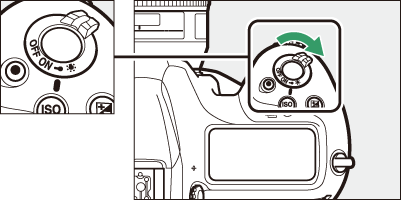
The Top Control Panel
The following indicators appear in the top control panel at default settings. For a full list of the indicators that may be displayed, see “Camera Displays” (The Top Control Panel) in “Technical Notes”.
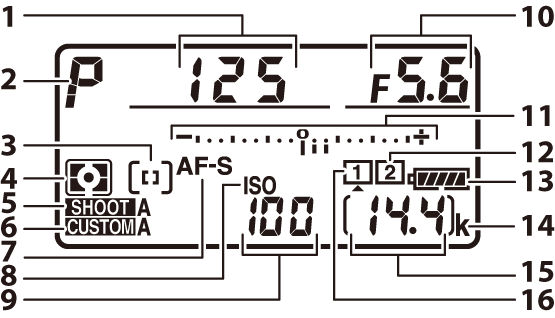
| 1 |
Shutter speed ( S (Shutter-Priority Auto) , M (Manual) ) |
|---|---|
| 2 |
Exposure mode ( Choosing an Exposure Mode , Choosing an Exposure Mode ) |
| 3 |
AF-area mode indicator ( Choosing an AF‑Area Mode , Choosing an AF-Area Mode) |
| 4 |
Metering ( Choosing a Metering Option , Exposure-Related Settings (Metering and Exposure Compensation) ) |
| 5 |
Photo shooting menu bank ( Photo Shooting Menu Bank ) |
| 6 |
Custom settings bank ( Custom Settings Bank ) |
| 7 |
Autofocus mode (Choosing an AF Mode, Autofocus Mode ) |
| 8 |
ISO sensitivity indicator ( The S (Q) Button , Adjusting the Camera’s Sensitivity to Light (ISO Sensitivity)) |
| 9 |
ISO sensitivity ( The S (Q) Button , Adjusting the Camera’s Sensitivity to Light (ISO Sensitivity)) |
|---|---|
| 10 |
Aperture (f-number; A (Aperture-Priority Auto) , M (Manual) ) |
| 11 |
Exposure indicator Exposure ( Exposure Indicators ) Exposure compensation ( Adjusting Exposure Compensation , Exposure Compensation ) |
| 12 |
Memory card icon (Slot 2; Memory Card Icons, Memory Card Indicators and Number of Exposures Remaining ) |
| 13 |
Battery indicator ( Battery Level ) |
| 14 |
“k” (appears when memory remains for over 1000 exposures; Memory Card Indicators and Number of Exposures Remaining ) |
| 15 |
Number of exposures remaining ( Memory Card Indicators and Number of Exposures Remaining , Memory Card Capacity ) |
| 16 |
Memory card icon (Slot 1; Memory Card Icons, Memory Card Indicators and Number of Exposures Remaining ) |
If the camera is turned off with a battery and memory card inserted, the memory card
icon, the number of photos in the current folder (q), and the number of exposures remaining (w) will be displayed in the top control panel. Depending on the memory card, the camera
may in rare cases not display this information when a card is inserted. This can be
addressed by turning the camera on.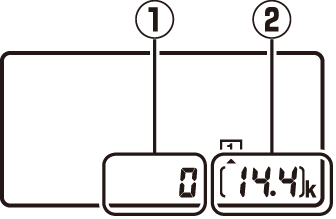
The Rear Control Panel
The following indicators appear in the rear control panel at default settings. For a full list of the indicators that may be displayed, see “Camera Displays” (The Rear Control Panel) in “Technical Notes”.
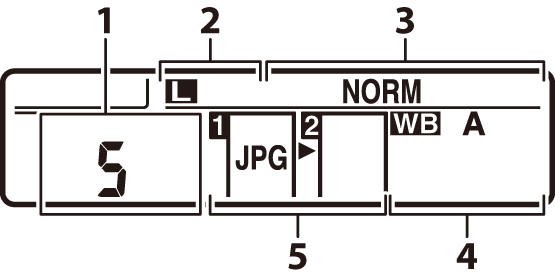
| 1 |
Release mode (Choosing a Release Mode, Choosing the Operation Performed When the Shutter Is Released (Release Mode) ) |
|---|---|
| 2 |
Size (JPEG images; Choosing an Image Size , Choosing an Image Size ) |
| 3 |
Image quality ( Adjusting Image Quality , Choosing an Image Quality Option) |
| 4 |
White balance ( Adjusting White Balance , Achieving Natural Colors with Different Light Sources (White Balance)) |
|---|---|
| 5 |
Role played by memory card in Slot 2 ( Using Two Memory Cards ) Image quality ( Adjusting Image Quality , Choosing an Image Quality Option) |
The Viewfinder
The following indicators appear in the viewfinder at default settings. For a full list of the indicators that may be displayed, see “Camera Displays” (The Viewfinder) in “Technical Notes”.
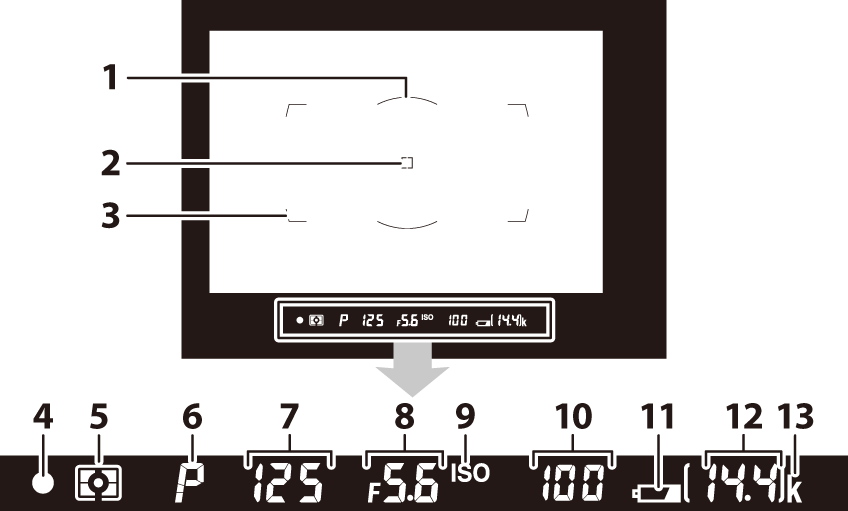
| 1 |
12-mm reference circle for center-weighted metering ( Choosing a Metering Option , Exposure-Related Settings (Metering and Exposure Compensation) ) |
|---|---|
| 2 |
Focus points ( Focus Point Selection ) |
| 3 |
AF-area brackets ( Framing Photographs in the Viewfinder (Viewfinder Photography) , Focus Point Selection ) |
| 4 |
Focus indicator ( Framing Photographs in the Viewfinder (Viewfinder Photography) , The Electronic Rangefinder ) |
| 5 |
Metering ( Choosing a Metering Option , Exposure-Related Settings (Metering and Exposure Compensation) ) |
| 6 |
Exposure mode ( Choosing an Exposure Mode , Choosing an Exposure Mode ) |
| 7 |
Shutter speed ( S (Shutter-Priority Auto) , M (Manual) ) Autofocus mode (Choosing an AF Mode, Autofocus Mode ) |
| 8 |
Aperture (f-number; A (Aperture-Priority Auto) , M (Manual) ) |
|---|---|
| 9 |
ISO sensitivity indicator ( The S (Q) Button , Adjusting the Camera’s Sensitivity to Light (ISO Sensitivity)) |
| 10 |
ISO sensitivity ( The S (Q) Button , Adjusting the Camera’s Sensitivity to Light (ISO Sensitivity)) AF-area mode ( Choosing an AF‑Area Mode , AF-Area Mode) |
| 11 |
Battery indicator ( Battery Level ) |
| 12 |
Number of exposures remaining ( Memory Card Indicators and Number of Exposures Remaining , Memory Card Capacity ) Number of shots remaining before memory buffer fills ( The Memory Buffer , Memory Card Capacity ) |
| 13 |
“k” (appears when memory remains for over 1000 exposures; Memory Card Indicators and Number of Exposures Remaining ) |
When the battery is exhausted or no battery is inserted, the display in the viewfinder will dim. The display will return to normal when a charged battery is inserted.
The brightness of the control panel and viewfinder displays varies with temperature, and response times may drop when the temperature is low; the displays will return to normal at room temperature.
To prevent light entering via the viewfinder interfering with photographs or exposure,
raise the viewfinder eyepiece shutter lever to close the viewfinder eyepiece shutter
when taking photos without your eye to the viewfinder.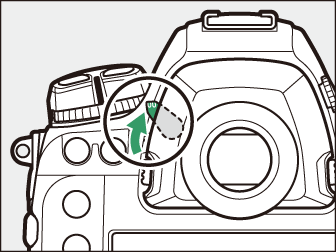
The viewfinder can be focused by lifting and rotating the diopter adjustment control.
With your eye to the viewfinder, rotate the diopter control until display in the viewfinder
is in sharp focus.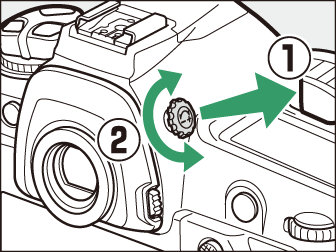
-
Corrective lenses (available separately) can be used to further adjust viewfinder diopter.
-
After adjusting diopter, push the diopter adjustment control back into its original position.
|
Viewfinder not in focus |
|
Viewfinder in focus |
The Live View Displays (Photos/Movies)
Press the a button to display the view through the lens in the monitor. Rotate the live view selector to C to take photographs or to 1 to record movies.
Live View Photography
The following indicators appear in the monitor at default settings. For a full list of the indicators that may be displayed, see “Camera Displays” (Still Photography) in “Technical Notes”.
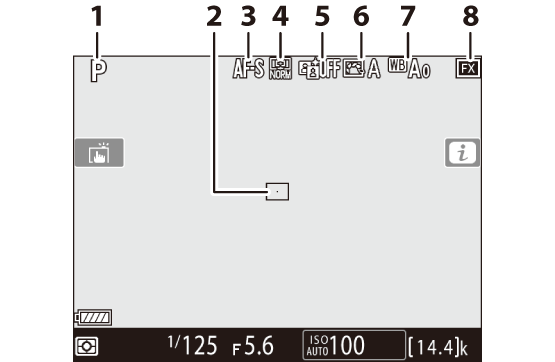
| 1 |
Exposure mode ( Choosing an Exposure Mode , Live View Photography and Filming) |
|---|---|
| 2 |
Focus point ( Focus Point Selection ) |
| 3 |
Autofocus mode (Choosing an AF Mode, Live View Photography and Filming) |
| 4 |
AF‑area mode ( Choosing an AF‑Area Mode , Live View Photography and Filming) |
| 5 |
Active D‑Lighting (Active D-Lighting) |
|---|---|
| 6 |
Picture Control ( The g (h/Q) Button , Image Processing (Picture Controls)) |
| 7 |
White balance ( Adjusting White Balance , Achieving Natural Colors with Different Light Sources (White Balance)) |
| 8 |
Image area ( Adjusting Image Area Settings ) |
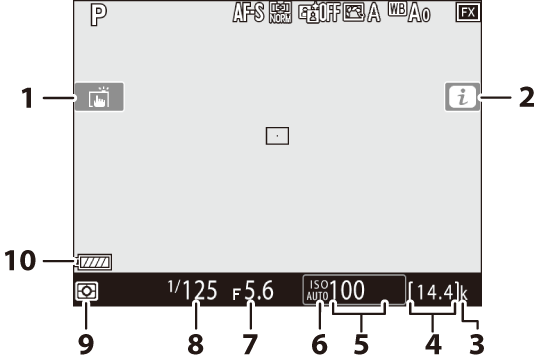
| 1 |
Touch shooting ( Touch Controls ) |
|---|---|
| 2 |
i icon ( The i Button (the i Menu) ) |
| 3 |
“k” (appears when memory remains for over 1000 exposures; Memory Card Indicators and Number of Exposures Remaining ) |
| 4 |
Number of exposures remaining ( Memory Card Indicators and Number of Exposures Remaining , Memory Card Capacity ) |
| 5 |
ISO sensitivity ( The S (Q) Button , Adjusting the Camera’s Sensitivity to Light (ISO Sensitivity)) |
| 6 |
ISO sensitivity indicator ( The S (Q) Button , Adjusting the Camera’s Sensitivity to Light (ISO Sensitivity)) |
|---|---|
| 7 |
Aperture ( A (Aperture-Priority Auto) , M (Manual) ) |
| 8 |
Shutter speed ( S (Shutter-Priority Auto) , M (Manual) ) |
| 9 |
Metering ( Choosing a Metering Option , Exposure-Related Settings (Metering and Exposure Compensation) ) |
| 10 |
Battery indicator ( Battery Level ) |
Movies
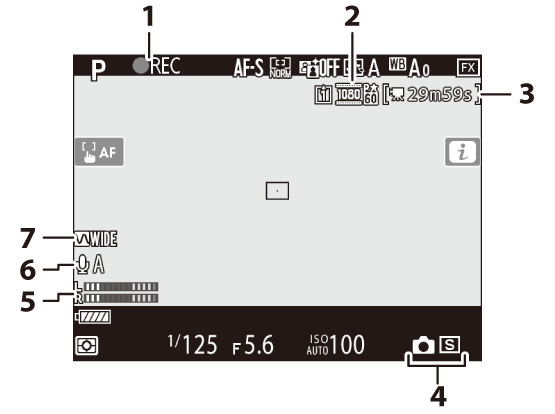
| 1 |
Recording indicator ( Recording Movies ) “No movie” indicator (Points to Note When Recording Movies) |
|---|---|
| 2 |
Frame size and rate/image quality ( Frame Size/Frame Rate and Movie Quality ) |
| 3 |
Time remaining ( Recording Movies ) |
| 4 |
Release mode (still photography; Taking Photos During Filming) |
| 5 |
Sound level (Recording Movies) |
|---|---|
| 6 |
Microphone sensitivity ( Microphone Sensitivity ) |
| 7 |
Frequency response ( Frequency Response ) |
Touch Controls
-
The touch-sensitive monitor offers a variety of controls that can be operated by touching the display with your fingers.
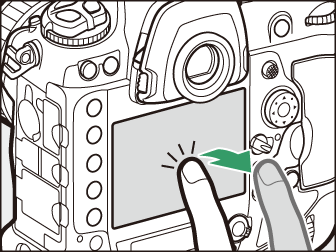
-
Touch controls can be used to:
-
Focus and release the shutter (Focusing and Releasing the Shutter)
-
Adjust settings (Adjusting Settings)
-
View pictures (Playback)
-
View movies (Viewing Movies)
-
Access the i menu (The i Menu )
-
Enter text (Text Entry)
-
Navigate the menus (Navigating the Menus)
-
Focusing and Releasing the Shutter
-
Touch the monitor during live view to focus on the selected point (touch AF).
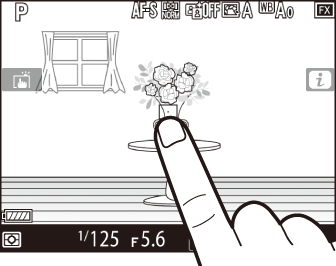
-
During still photography, the shutter will be released when you lift your finger from the display (touch shutter).
-
Touch AF settings can be adjusted by tapping the W icon.
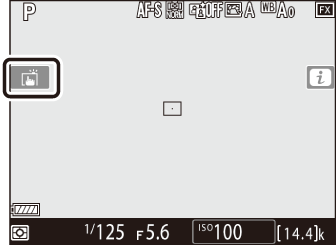
Adjusting Settings
-
Tap highlighted settings in the display.
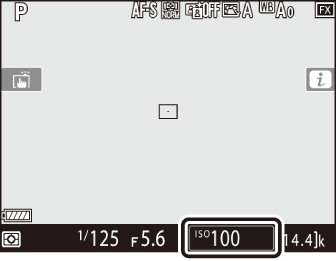
-
You can then choose the desired option by tapping icons or sliders.
-
Tap Z or press J to select the chosen option and return to the previous display.
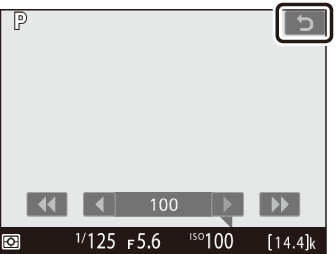
Playback
-
Flick left or right to view other pictures during full-frame playback.
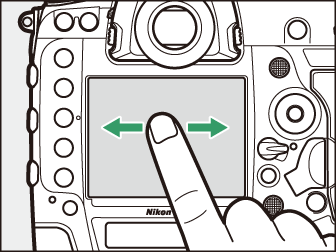
-
In full-frame playback, touching the bottom of the display brings up a frame-advance bar. Slide your finger left or right over the bar to scroll rapidly to other pictures.
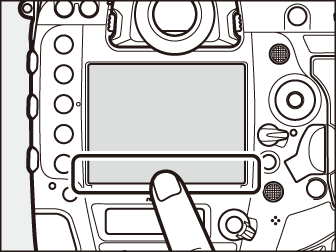
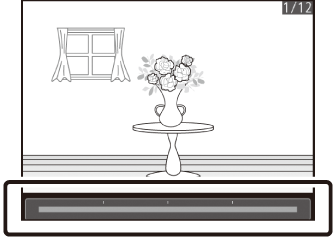
-
To zoom in on a picture displayed in full-frame playback, use a stretch gesture or give the display two quick taps. After zooming in, you can adjust the zoom ratio using stretch gestures to zoom in and pinch gestures to zoom out.
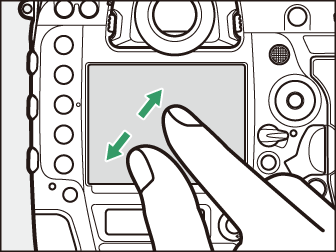
-
Use slide gestures to view other parts of the image during zoom.
-
Giving the display two quick taps while zoom is in effect cancels zoom.
-
To “zoom out” to a thumbnail view, use a pinch gesture in full-frame playback. Use pinch and stretch to choose the number of images displayed from 4, 9, and 72 frames.
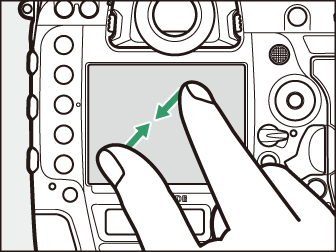
Viewing Movies
-
Movies are indicated by a 1 icon; to start playback, tap the on-screen guide.
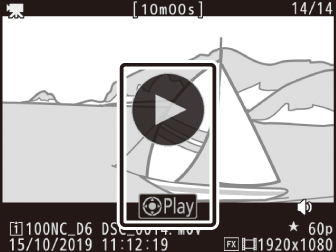
-
Tap the display to pause. Tap again to resume.
-
Tap Z to exit to full-frame playback.
The i Menu
When the i menu (
The i Button (the i Menu)
) is displayed, you can tap items to view options.
Text Entry
-
When a keyboard is displayed, you can enter text by tapping the keys.
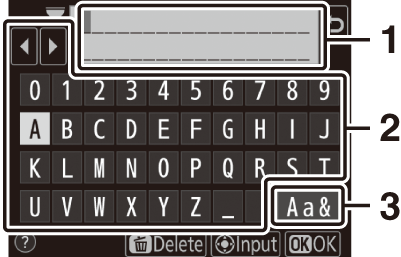
1 Text display area
2 Keyboard area
3 Keyboard selection
-
To position the cursor, tap e or f or tap directly in the text display area.
-
To cycle through the upper- and lower-case and symbol keyboards, tap the keyboard selection button.
Navigating the Menus
-
After pressing the G button to display the menus, you can slide up or down to scroll.
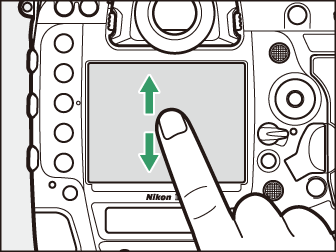
-
Tap a menu icon to choose a menu.
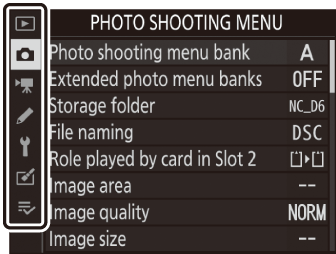
-
Tap menu items to display options. You can then choose the desired option by tapping icons or sliders.

-
To exit without changing settings, tap Z.
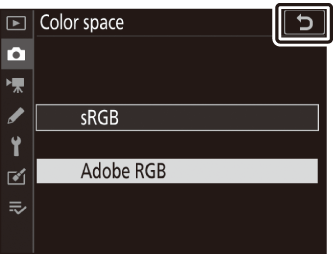
-
The touch screen responds to static electricity. It may not respond when touched with fingernails or gloved hands. For improved response when using the touch screen with gloves, select [] for [] > [] in the setup menu.
-
Do not touch the screen with sharp objects.
-
Do not use excessive force.
-
The screen may not respond when covered with third-party protective films.
-
The screen may not respond when touched simultaneously in multiple locations.
Touch controls can be enabled or disabled using the [] item in the setup menu.

